Few paintings in the history of art have caused as much talk and discussion as Giorgione ’s The Tempest (Giorgio Barbarelli; Castelfranco Veneto, 1478 - Venice, 1510), preserved at the Accademia Gallery in Venice, a work of art exactly as mysterious as its author. Of Giorgione, in fact, we know little: his real name has only recently been discovered, and very few documents can provide certain evidence of his existence. There are in fact only four documents that concern him directly: these are the receipt of a commission for a canvass to be placed in the Doge’s Palace in Venice, dated 1507; a lawsuit dated 1508 and brought against the commissioners of the frescoes in the Fondaco dei Tedeschi, also in Venice; the inventory of his possessions at the time of his disappearance; and a letter written in 1510 to Isabella d’Este by Taddeo Albano, an agent who operated in Venice on behalf of the marquise and who in his letter gives Isabella d’Este notice of the painter’s death at the age of thirty-two. To these can be added an inscription that appears on the back of a famous painting by giorgione, the Laura preserved in the Kunsthistorisches Museum in Vienna.
This inscription (“1506 adj. primo zugno fo fatto questo de ma[no] de maistro zorzi da chastel fr[anco] cholega de maistro vizenzo chaena ad instanzia de mis. giac.mo”) attests to him as “Zorzi da Castelfranco,” “Zorzi” obviously being diminutive of Giorgio in Venetian dialect, and points to him as a “colleague” of Vincenzo Catena, a Bellini-like painter who was perhaps, according to some, a master of Giorgione himself. In this context “colleague” means that the painter did not have a workshop of his own, but rather was associated with Vincenzo Catena. A paucity of information that is almost unbelievable considering the fact that Giorgione is one of the most influential painters in the history of art, and a paucity of information that certainly does not even help us shed light on his best-known painting, the Tempest. To understand him better, however, it is necessary to start with the particular environment within which Giorgione conducted his artistic activity. To get into this environment, one can turn to the Lives of Giorgio Vasari, the first of the biographers who helped fuel the myth of Giorgione. Vasari says that Giorgione continually delighted in “things of love,” played the lute and sang, and apparently sang so well that he was often called to the parties of Venetian nobles (“dilettossi continovamente de le cose d’amore e piacqueli il suono del liuto mirabilmente e tanto, che egli sonava e cantava nel suo tempo tanto divinamente, che egli era spesso per quello adoperato a diverse musiche e ragunate di persone nobili” ").
After all, music plays a prominent role in Giorgione’s art: a detail of one of his few certain works, the Frieze of the Liberal and Mechanical Arts, depicts precisely some musical instruments. From this description by Vasari we glean the information that Giorgione used to frequent the most prominent circles in Venice at the time, those noble circles in which art, love, and literature were discussed, which are also reflected in the literature of the time (just think of Pietro Bembo’s Asolani ), and which shared their own cultural codes. So it is perhaps to this activity that we must trace The Tempest, a painting that has been a source of discussion for five hundred years without any certain conclusion.
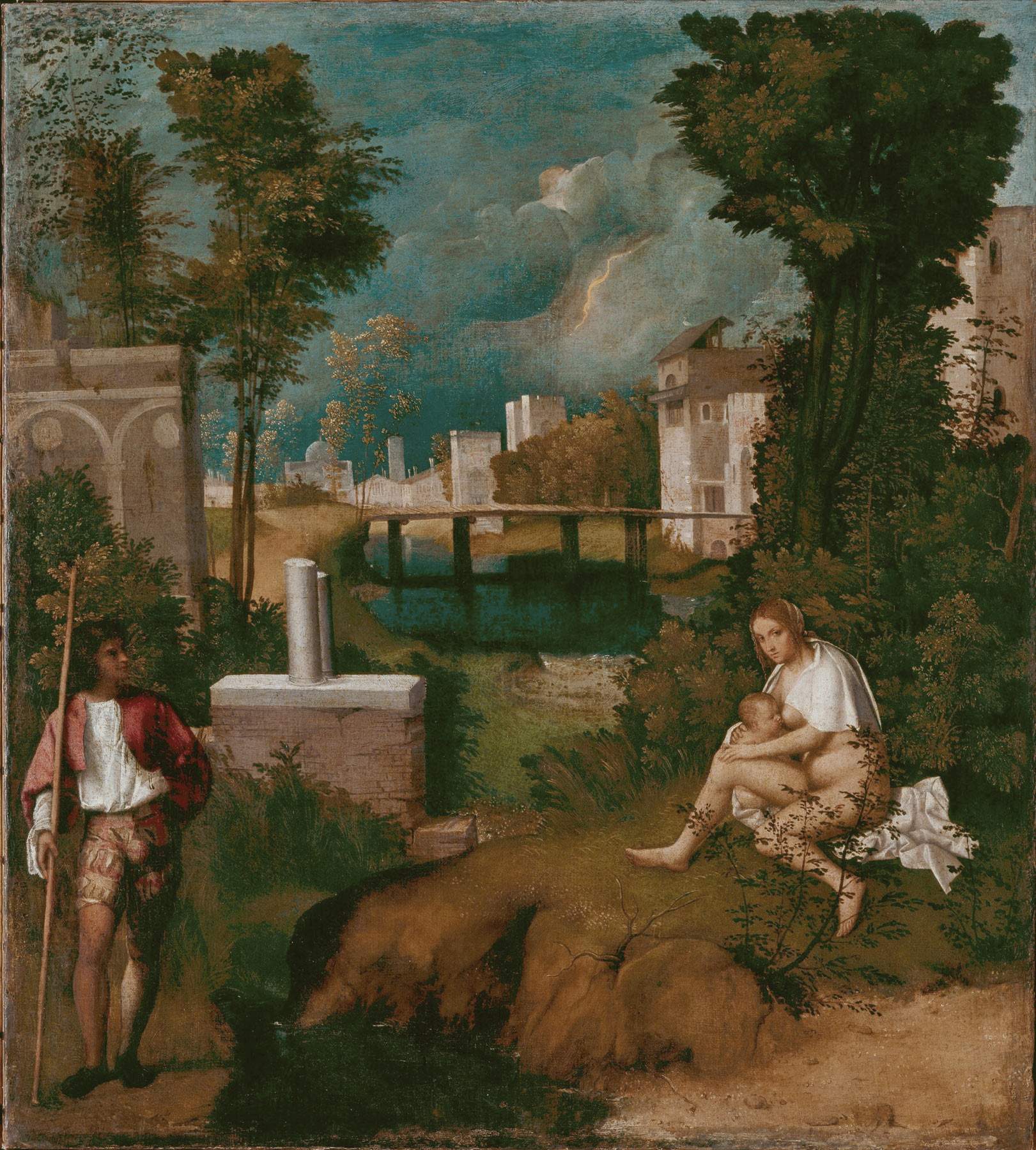
This is because the meaning escapes us, but perhaps it could have been understood by the commissioner: the painting may have been commissioned by a nobleman named Gabriele Vendramin, who owned the painting in 1530. If, on the other hand, Vendramin was not the commissioner, it is still almost certain that such a painting must have been understandable to those who shared the same cultural code as Giorgione. The Tempest, a celebrated, powerful, evocative painting that leaves the viewer stunned, was probably made between 1502 and 1505: for a long time traces of it were lost. In the 19th century, it was in the house of the Giovannelli princes, where the scholar Angelo Conti saw it, after which, in 1932, it was purchased by the City of Venice and destined for the Gallerie dell’Accademia. The work strikes the relative above all for its unforgettable landscape: in the background a city can be seen, crossed by a stream, which in turn is crossed by a bridge, and a furious thunderstorm is about to break over the city. Indeed, gloomy clouds can be seen gathering over the towers, and lightning can already be seen ripping through the sky, foreshadowing the violence of the coming storm. It is precisely the lightning bolt that is one of the most important elements of the composition, for it shows how Giorgione cultivated a strong interest in the depiction of natural phenomena, revealing the aptitude and interests of a painter of great modernity. In the foreground we then notice some classical ruins, see the rocks, the trees that are agitated by the wind heralding the storm, but above all we can make out two figures, a man with a long stick and a woman nursing a child.
Before trying to identify the two figures, it is necessary to focus on the landscape, perhaps the real protagonist of The Tempest, just as it is the protagonist of other works by the painter, such as Sunset, preserved at the National Gallery in London, or Homage toSaturn, also known as Homage to a Poet, also preserved at the National Gallery in London. In all of these paintings, including The Tempest , the landscape occupies a central role, nature plays an extremely important function, and above all the landscape is real, for it is that of the Veneto, the same one that Giorgione could see every day, so much so that the town depicted in The Tempest has alternately been identified as Montagnana, near Padua, or as the painter’s hometown, Castelfranco Veneto, and finally as Padua itself. These are landscapes that evoke evocative atmospheres, landscapes that could be described as idyllic, landscapes that are skillfully delineated through the use of tonal painting, which Giorgione brings to its heights from the experience of Giovanni Bellini. Tonal painting, of which Giorgione would be the father according to many art historians, is the pictorial language that is established in the Renaissance Veneto: the depth of the works of art is not governed by geometric laws but by colors, thus by the warm tones used to paint the elements close to the viewer’s point of view and, conversely, by the cool tones for the objects in the distance, with nuanced and gradual transitions of tone, without contour lines. This can be seen when observing the Tempest itself, with the colors becoming more and more evanescent as the objects depicted move away.
The two characters depicted are perfectly cast in this landscape, and one has always wondered who they might be. It is, however, extremely difficult, not to say impossible, to determine which is the most likely hypothesis, for the simple fact that we do not have much information about the painting, so any hypothesis could be the right one, but it is also possible that the solution has not even been touched upon in the slightest. The Tempest is, in short, an extremely difficult painting: “the most reticent of all Giorgione’s reticent paintings,” Augusto Gentili called it, for whom the work cannot even rise to the status of a “masterpiece,” nor of a cornerstone of 16th-century Venetian painting: “a masterpiece,” Gentili wrote, “clearly defines its subject and serves it functionally with property and coherence of iconography and language, without forcing the viewer into guessing games; a caposaldo generates a network of relationships and developments, of experiments and surpasses, and not two or three semi-anonymous imitations. Dating is also particularly difficult, because executive discontinuity blows up the parameters of ’stylistic’ judgment (which therefore prove approximate, conjectural, illusory). There is no narrative or information, no gestural cues or expressive suggestions, and not even repertorically recognizable symbolic elements.” Nevertheless, many have tried to read the painting by attempting to interpret it, and over time dozens of readings have been formulated, so much so that, as Enrico Maria Dal Pozzolo recently wrote, by now there is at least one new interpretation of the Tempest peryear, in a long chain that “alternates more or less plausible readings with others that are improbable, if not delusional,” with attempts that “often erudite and ingenious, in the end seem to elide one another.” Too unusual, in short, is the subject painted by Giorgione.
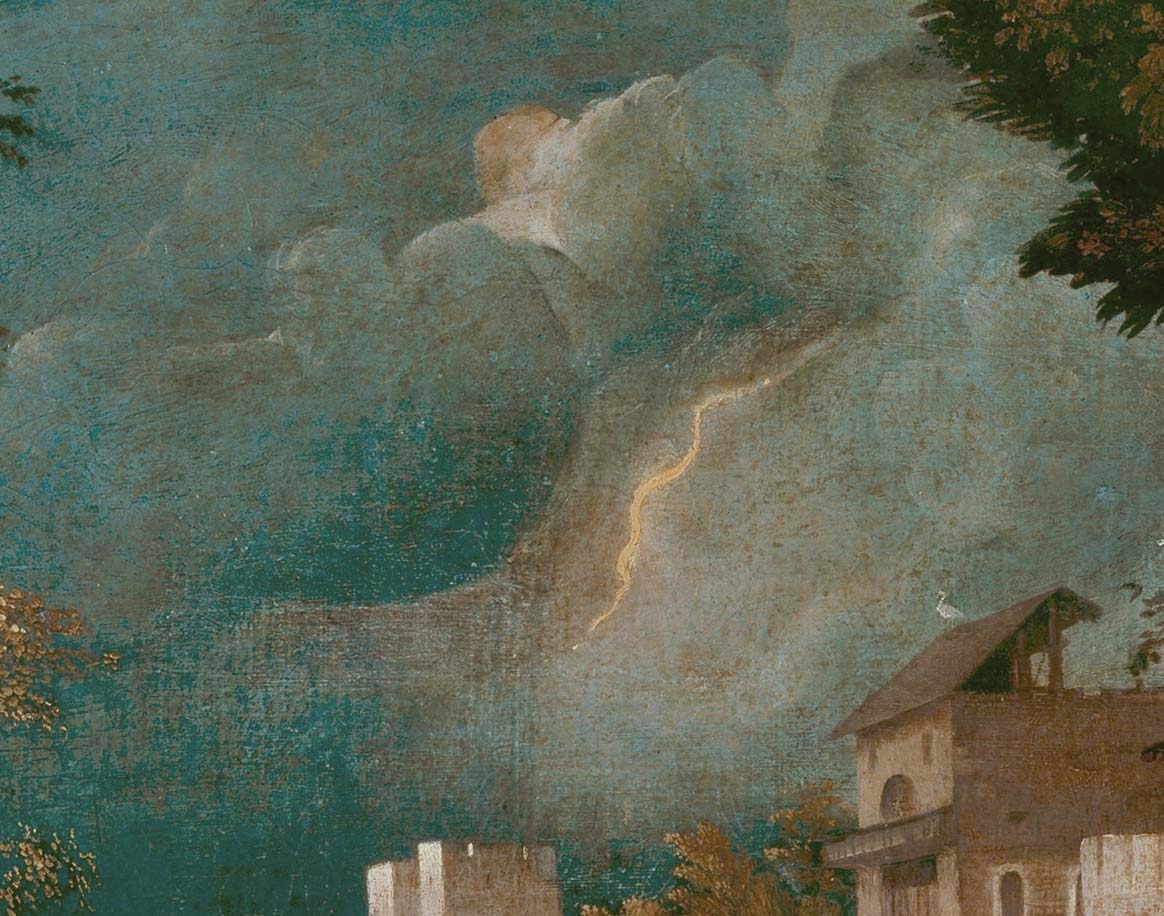
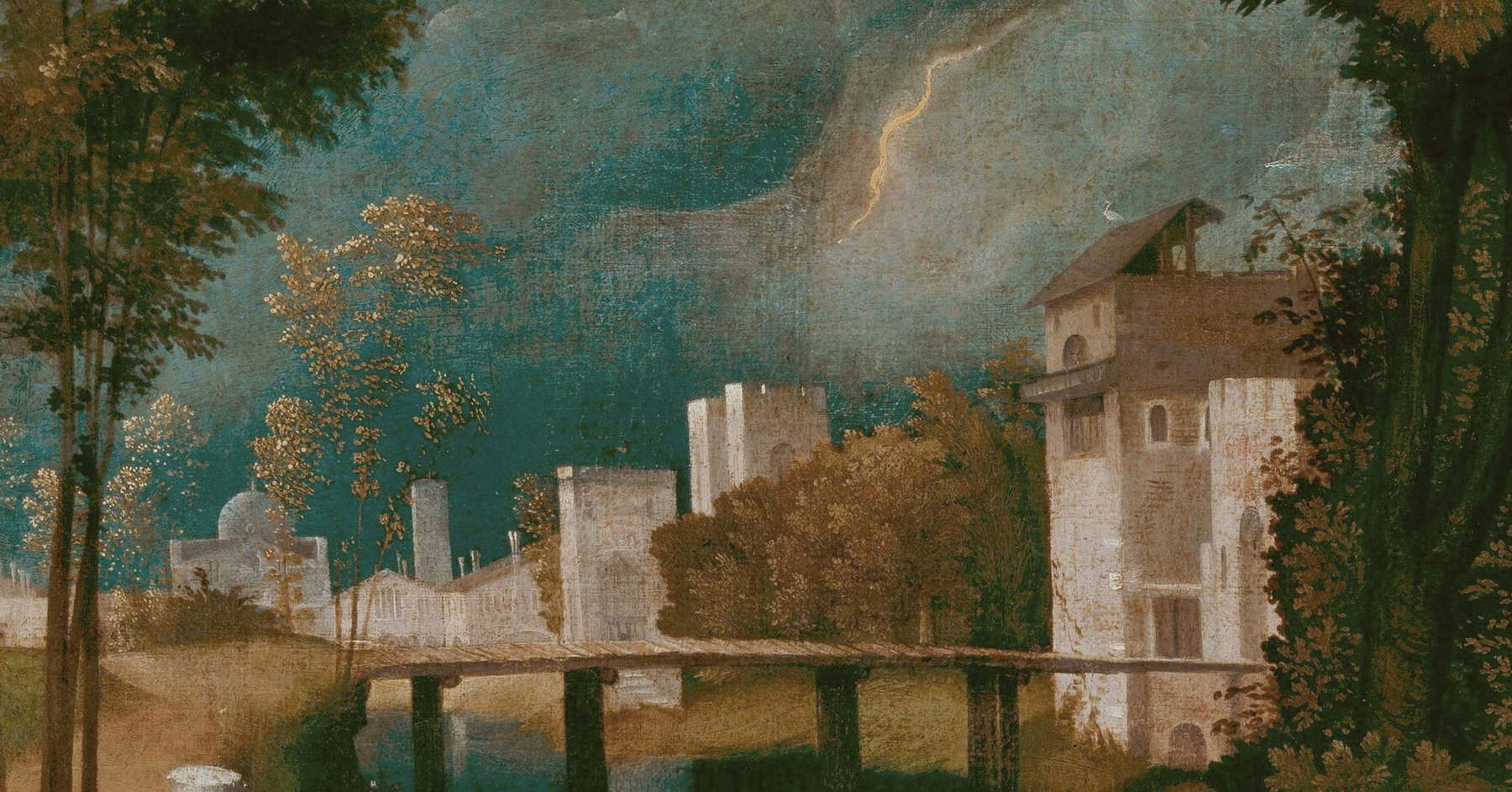
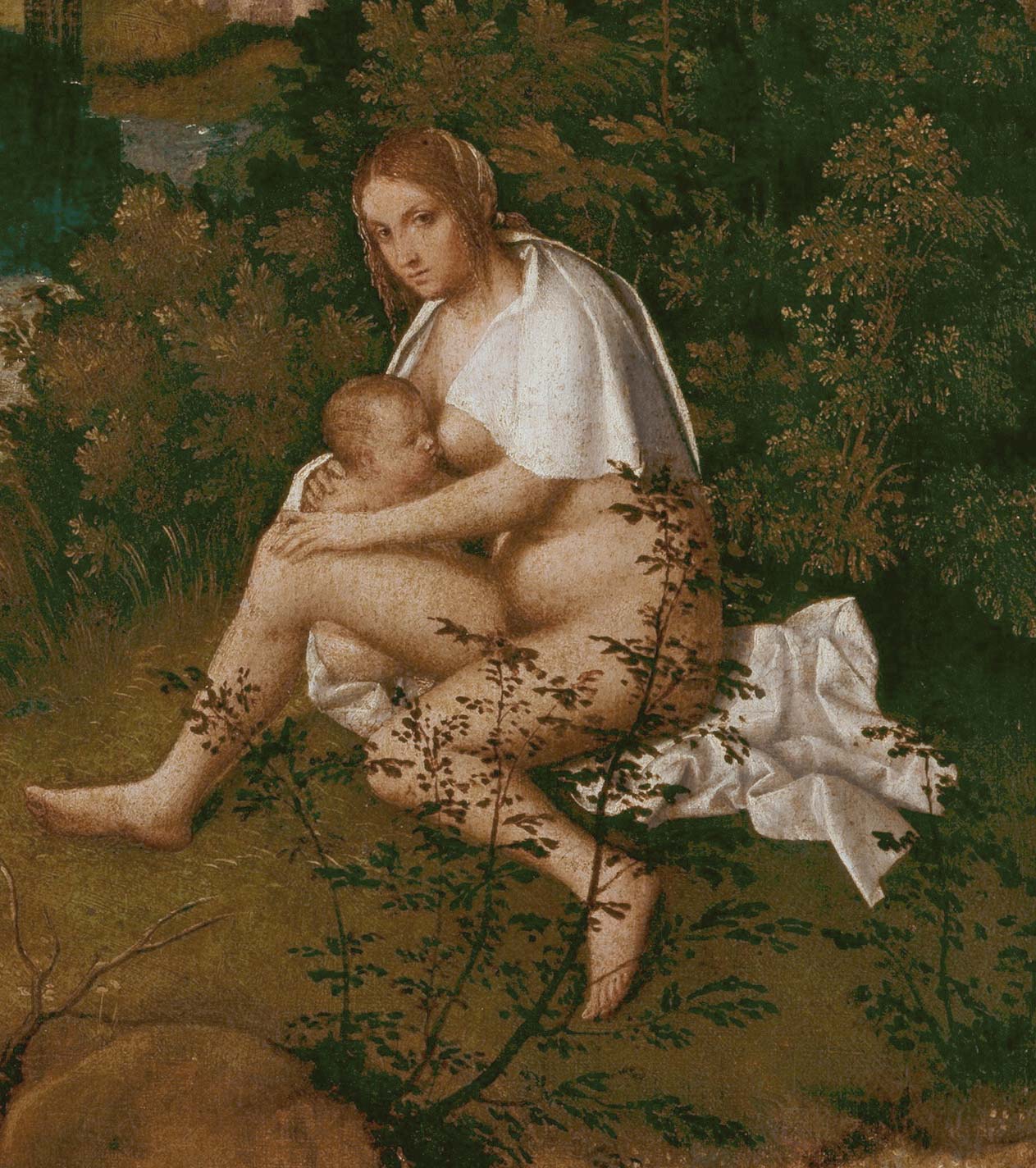
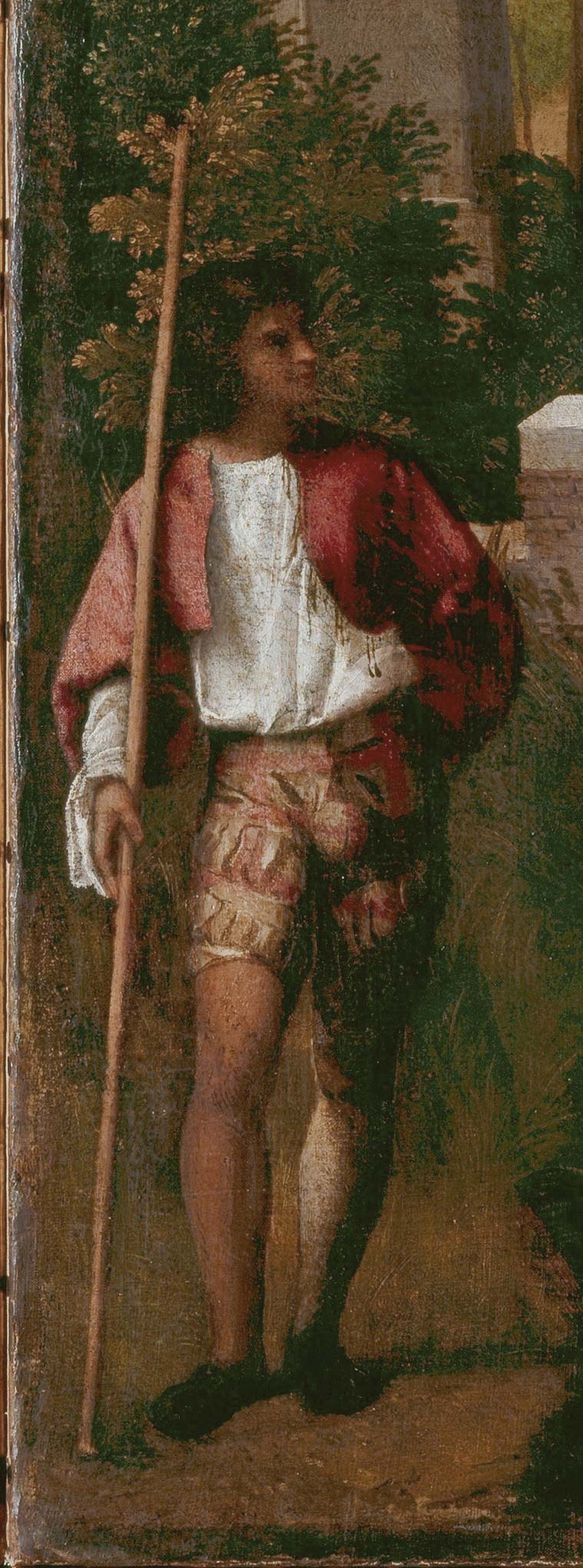
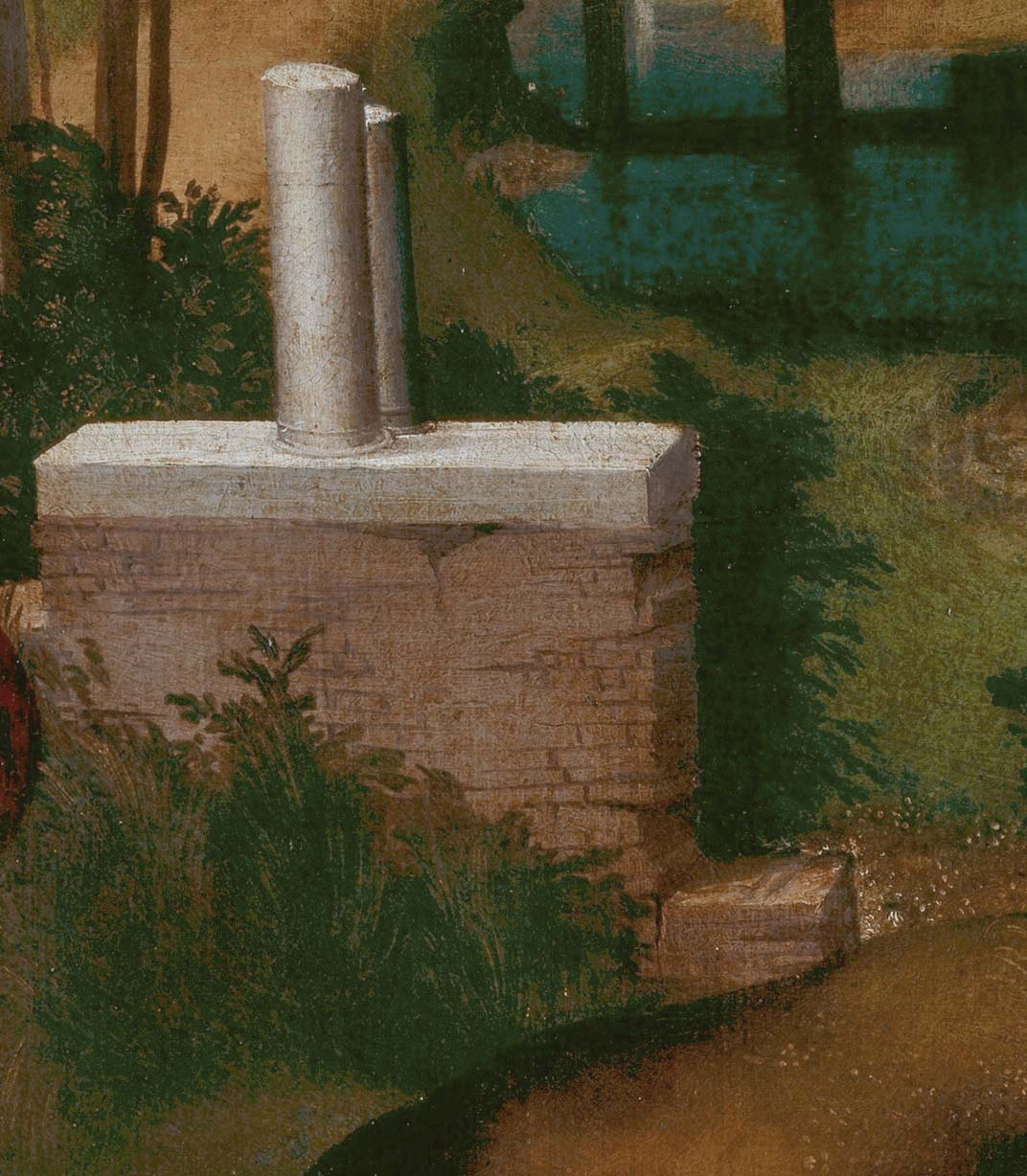
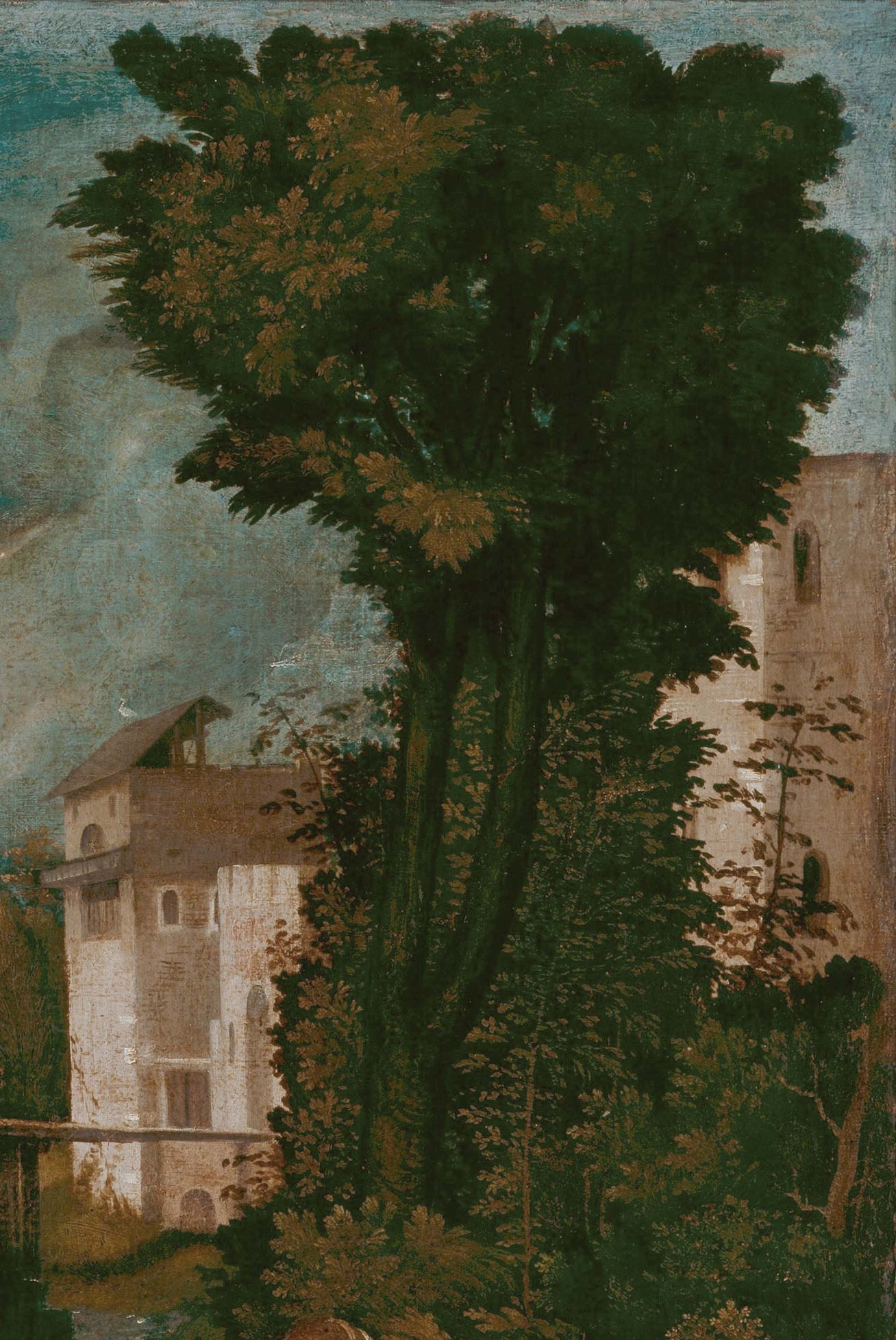
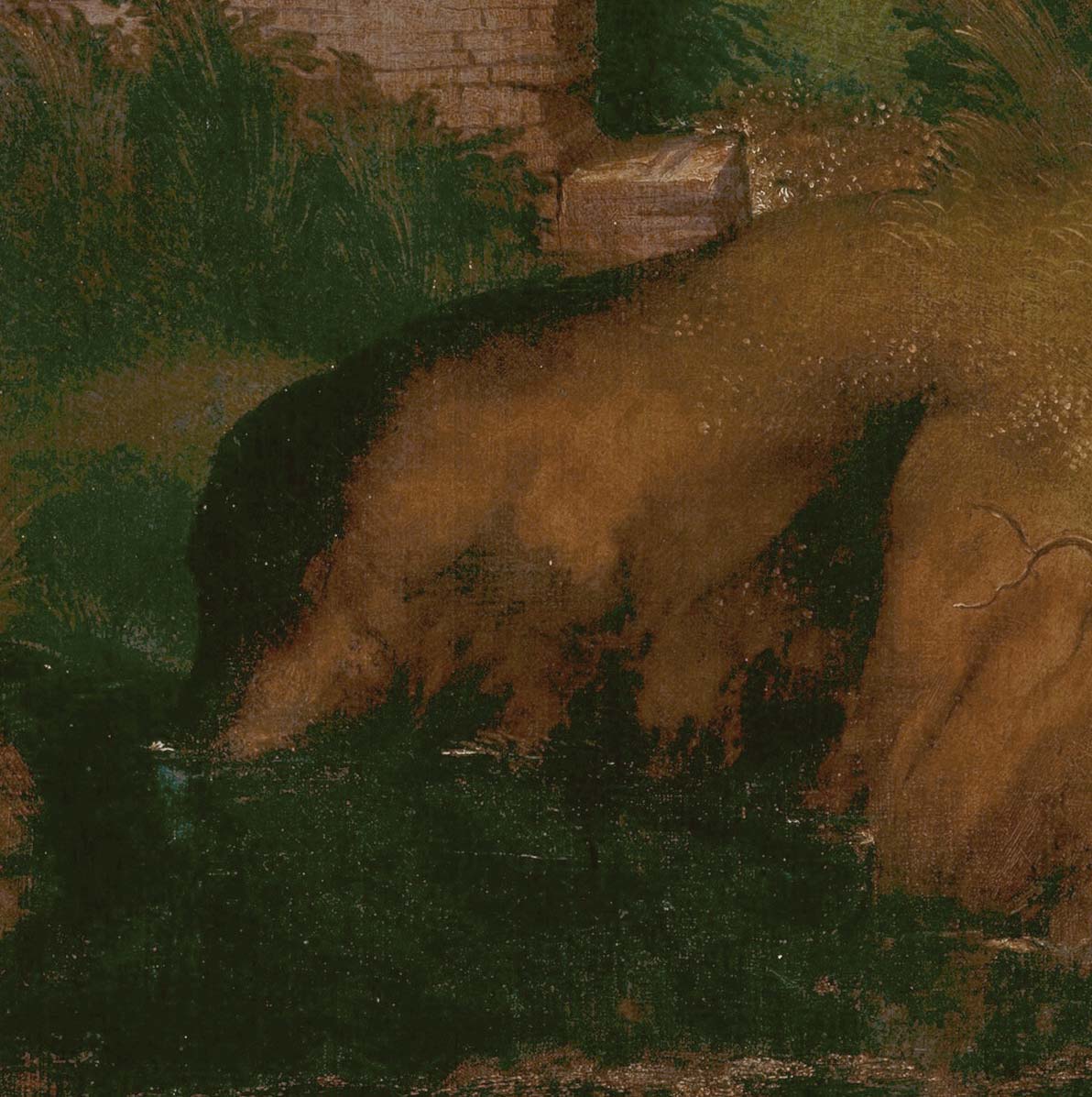 The
TheHowever, it is worth mentioning a few hypotheses, among those that have had more luck and those that have been formulated in more recent times. The first and oldest simply holds that the woman is a gypsy, and the man a soldier. This theory was first proposed by Marcantonio Michiel (Venice, 1484 - 1552), an art collector contemporary with Giorgione: one finds the reference to the Tempest and its possible interpretation, a reference that by the way is the first to be found, in an annotation by the collector dating from around 1530. Other interpretations range from allegory to mythology via religion and literature. Angelo Conti, in his 1894 study of Giorgione, praised by Gabriele d’Annunzio, argued that the theme of the painting is fatherhood: the man is the father and, with the birth of the child suckled by his partner, “the poem of love closes,” meaning that pleasure and voluptuousness have given the world a new life. One of the most famous hypotheses dates back to 1978 and was formulated by Salvatore Settis, according to whom the figures are Adam and Eve after the expulsion from the Earthly Paradise, with the woman suckling the baby Cain: according to the scholar, the painting is an allusion to man’s condition following the expulsion, with the city in the background symbolizing Eden and the storm the divine fury. According to George Martin Richter, it is instead a mythological episode: the hypothesis is from 1937 and the child would be the abandoned baby Paris, the man the shepherd who found him and the woman the wet nurse who raised him, and of course the city in the background would be Troy. Also of mythological origin is Rudolf Schrey’s interpretation, dated 1915, that the couple would represent Deucalion and Pyrrha, and the storm is obviously the deluge unleashed by Zeus, similar to the biblical universal flood, and the two would, according to the myth, be the only survivors chosen by the god himself as they were not corrupted like the rest of humanity. Interestingly, according to this interpretation, the storm would not be starting but stopping.
In 1895, on the other hand, Franz Wickhoff had recognized in the Tempest a scene from Statius’ Thebaid , a theme thus taken from classical literature, and the episode would see Adrastus, king of Thebes, discovering in a forest Ipsipile, queen of the island of Lemno, while she is nursing the baby hero Ophletes. Another hypothesis came in 1969 with Edgar Wind, according to whom the painting should be understood in a religious sense: the man would represent the virtue of fortitude and the woman that of charity, in line with the traditional iconography of charity that personifies that virtue in the form of a woman nursing a child.
Among the most recent interpretations it is worth mentioning, in order of time, those of Carlo Falciani (2009), Ugo Soragni (2010), Maria Daniela Lunghi (2015) and Sergio Alcamo (2019). Falciani has given a Virgilian reading, connected to the events of the Vendramin household: the work should be interpreted as the birth of Silvius, son of Aeneas and Lavinia, and successor to his half-brother Ascanius as king of the Latins. The standing man would be Silvius himself caught contemplating his own birth as an adult, a situation that would evoke the passage in theAeneid in which Anchises welcomes Aeneas during the latter’s passage into the afterlife by revealing to him the birth of his son. According to Soragni, who formulated his theory on the occasion of the exhibition Giorgione in Padua . The Enigma of the Chariot held at the Musei Civici agli Eremitani in Padua between 2010 and 2011, the Tempest would be “the paradoxically most explicit and least investigated testimony to Giorgione’s interest in Padua, in which allusions and references to a plurality of Paduan subjects are condensed, alongside the depiction of some of its most representative monuments: from the founding of the city by Antenor to the dramatic end of the Carrarese seigniory, from the flooding of the contado resulting from the works carried out by the Venetians to ensure the hydraulic stability of the lagoon, to the constant concern about the outbreak and spread of the plague, from the great undertaking of the reconstruction of the Carmini dome, completed a few years earlier, to the wooden bridges that took the place of the solid stone buildings inherited from the ancient world.” On that occasion, it was suggested that the chariot depicted near the city gate would allude to the Carraresi, the lords of Padua, and that in the outline of the city the profile of the Carmini church could be unmistakably distinguished: the woman would thus be an allegory of the city of Padua, caught nursing Venice (an allusion to the fact that the lagoon city is of much more recent foundation than the Euganean city), while the man would be a “stradioto,” a Venetian mercenary.






 The
TheThe scholar Maria Daniela Lunghi has instead linked the Tempest to the legend of St. John Chrysostom, according to which the saint, at a certain point in his life, decided to retire to an ascetic life in the desert of Syria: however, having come across the young daughter of a local ruler, he fell in love with her, reciprocated, and after uniting with her he was seized with remorse for having contravened the principles of his religious faith. The saint would therefore decide to kill the young woman by throwing her off a cliff and to live out the rest of his days as a savage: however, repenting on the basis of the idea that one cannot atone for a fault by committing a crime, he would confess the crime to the king’s soldiers. These, having gone to the scene of the misdeed, would end up finding the girl alive, intent on nursing a child, the fruit of her union with John Chrysostom. For Lunghi, the iconographic fortune of this subject among artists of the time (Albrecht Dürer, Lucas Cranach, Giulio Campagnola, Andrea Zoan and others are listed) would justify Giorgione’s knowledge of it, who, according to the scholar, may have kept in mind if nothing else Albrecht Dürer’s engraving, on this theme, due to the fact that the artist stayed in Venice at the time Giorgione was waiting for The Tempest. However, Giorgione’s painting would lack the figure of John Chrysostom: according to Lunghi, the artist would have wanted in this sense to offer his own interpretation of the legend by focusing on the figure of the young woman and that of the soldier who discovered her.
Finally, there is the interpretation of Sergio Alcamo who, by first identifying a small angel on the wooden bridge (painted, according to Alcamo, to cover the figure of a wayfarer previously painted by Giorgione and then covered: repentance has emerged from recent diagnostic investigations on the work), of which previous critics had not noticed, has recovered Salvatore Settis’s religious reading in order to update it. According to Alcamo, the Tempest would be an allegory of redemption: the man would be Adam, and the staff on which he leans would be an allegory of the tree of knowledge, being made of wood. The woman would still be Eve, while the child would be Seth, the couple’s third son. The two columns, on the other hand, are a very rare iconographic subject, of which Alcamo found a precedent only several years later in a fresco in the Vatican Library, painted by Giovanni Baglione between 1587 and 1589: these would be the “Columns of the Sons of Seth,” those on which would be inscribed scientific and astronomical discoveries, erected by the descendants of Seth (who again according to Alcamo was depicted in the guise of the wayfarer later removed) on the basis of Adam’s prediction that the world would be destroyed twice, so as to preserve knowledge after destruction.
These are just a few of the interpretations, but one almost gets the impression that the more the critics strive to provide their theories, the more elusive the meaning of Giorgione’s Tempest becomes: thus, it is likely that we will never be able to understand whether there is something behind the painting and, if so, what it is. “Perhaps one day,” Ernst Gombrich has written in connection with this painting, “one will be able to identify the episode portrayed here, which may be the story of the mother of some future hero driven out with her child from the city into the woods, where she is discovered by a kindly young shepherd. This seems to be the theme that Giorgione wanted to portray. But not because of its subject the painting is one of the most marvelous creations in art. It will be difficult for a small-scale reproduction to give us an idea of it, yet it too can serve to open a glimmer of Giorgione’s revolutionary achievements.” For the time being, therefore, we are content to be amazed at the most famous work of one of the greatest and at the same time most mysterious masters in the history of art, who over time has become more of a myth than an artist.
Warning: the translation into English of the original Italian article was created using automatic tools. We undertake to review all articles, but we do not guarantee the total absence of inaccuracies in the translation due to the program. You can find the original by clicking on the ITA button. If you find any mistake,please contact us.